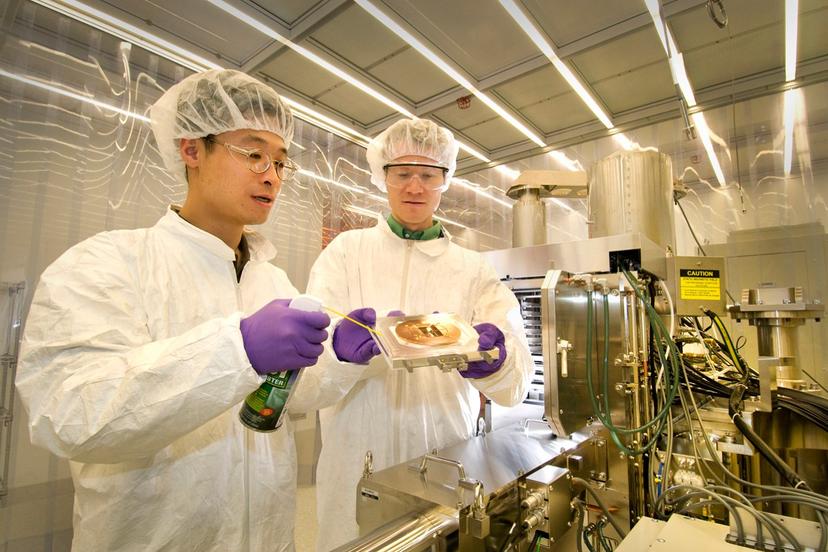Nanotechnology

Background
Since ancient times, crafts workers have discovered uses for nanomaterials without understanding the physical principles governing those materials. For example, ancient artisans learned to create a type of glass that changes color when light shines through it because it contains traces of colloidal gold and silver. (A colloid is a substance microscopically dispersed within another substance.) Medieval Europe's stained glass achieved brilliant colors through the use of nanoparticles of metal oxides and chlorides. In the medieval Islamic world, potters developed glittering ceramic glazes by incorporating silver, copper, or other metallic nanoparticles, and the swordsmiths of Damascus forged sabers that incorporated carbon nanotubes.
Modern understanding of nanotechnology may be said to start with the work of Michael Faraday, who recognized in 1857 that colloidal gold particles are able to create a ruby-red color in stained glass and liquids because of their minute size. Industrial production of monodisperse colloids (in which all the particles are of uniform size) received a major boost in 1950 from the theoretical and applied work of Victor LaMer and Robert Dinegar, chemists at Columbia University.
Faraday's contemporary, John Dalton, established the modern understanding of atoms and molecules, but it was not until 1936 that the field emission microscope enabled researchers to create images of nanoscale structures. Resolution increased with the field ion microscope in 1951 and finally reached the atomic scale in 1981, with the scanning tunneling microscope.
Once atoms and molecules were made visible, interest in manipulating them was a logical next step. In 1959, Richard Feynman of Caltech gave an influential lecture in which he challenged the scientific community to undertake what became known as nanoengineering (a term not coined until 1974): "The principles of physics, as far as I can see, do not speak against the possibility of maneuvering things atom by atom." The need for this work was also implied by the founder of Intel, Gordon Moore, when he observed in 1965 that the density of transistors on integrated chips was doubling every year or so.
Nanoscale microscopy works by creating an electric field between an extremely sharp metal tip and the nanoscale structure being examined. The way to accomplish nanoscale manipulation was to use this tip to move atoms, and in 1986 scientists at an IBM lab demonstrated this capability, manipulating 35 xenon atoms to spell out the corporate logo.
In the 1980s and 1990s, nanoscale microscopy also revealed the molecular structure of materials with properties that would be useful if they could be engineered into practical applications. Buckyballs, a hollow arrangement of 60 carbon atoms into a shape resembling a soccer ball, held the promise of serving as a sort of capsule. Carbon nanotubes turned out to be extraordinarily strong and conductive of heat and electricity, inspiring plans to use them to form nanowires and tough fabrics. Graphene, a one-atom-thick sheet of carbon, later was isolated and found to have useful properties. Tiny semiconducting crystals called quantum dots were found to be "tunable"—their conductive and fluorescent properties could be adjusted by manipulating their size and shape. Researchers at Mobil discovered a form of silica with regularly spaced pores whose size could be engineered, allowing the material to serve as a molecular sieve.
As the century turned, industry began to apply the discoveries of the material scientists and engineers, using carbon nanotubes to manufacture stiffer tennis racquets, nanoparticles of silver to give socks antibacterial properties, and incorporating other nanomaterials in adhesives, toothpastes, detergents, sunblock lotions, paints, nonscratch glass coatings, and scores of other products. The global nanotechnology market is expected to exceed $125 billion by 2024.
Several government agencies were encouraging industry to exploit this new technology. In response, the federal government created the National Nanotechnology Initiative in 2000 to coordinate the relevant programs being funded by various agencies. In 2015, cumulative government investment through NNI totaled almost $21 billion. The cumulative funding for NNI, including the federal budget, was expected to be about $27 billion in 2019, based on the proposed federal budget. The NNI stated that the funding reflects "a sustained emphasis broad, fundamental research in nanoscience to provide a continuing pipeline of new discoveries that will enable future transformative commercial products and services." The funding was expected to be spent as follows: 39 percent to foundational research, 28 percent to applications and devices, and 16 percent to infrastructure and instrumentation.
However, the NNI and the nanotechnology industry have attracted controversy in the past. In 2008 and again in 2012, the National Academy of Sciences issued reports criticizing the NNI for not sponsoring research into the possible risks of nanomaterials. For example, it is not known what effects will be produced when nanoparticles from products such as skin creams and clothing are inhaled or absorbed through the skin, nor the consequences of their release into the environment during manufacturing and disposal. When a government agency is charged with both oversight and development, questions arise and criticism follows.
